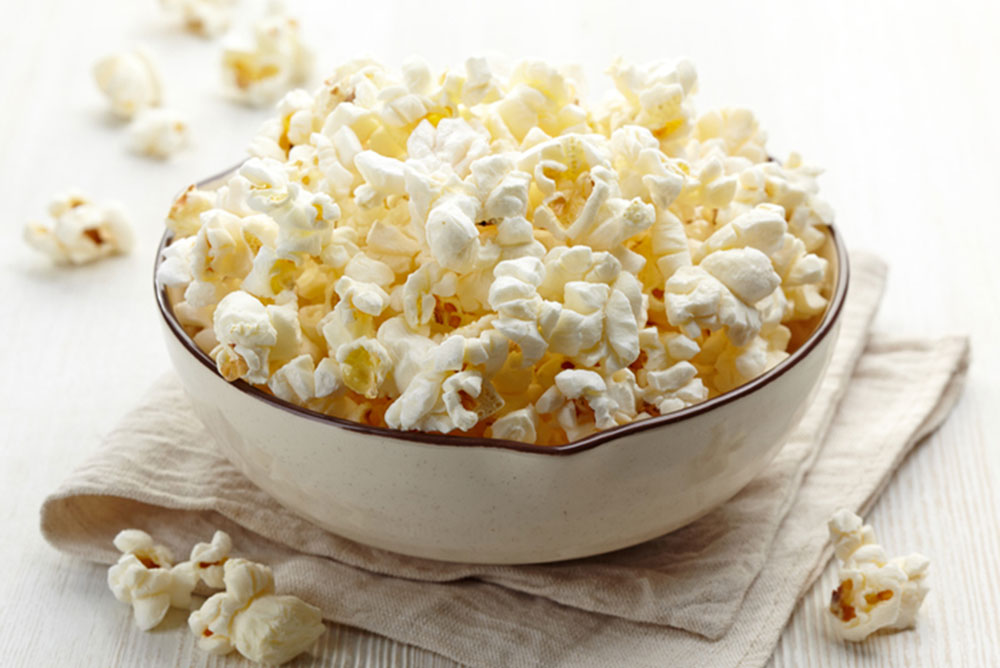
iStock
A LARGE GIFT CARTON from a favorite friend arrived with 24 bags of Skinny Pop popcorn. What a treat! So many bags, ready to eat and only 100 calories each.
Around the same time came great news —that popcorn qualifies as a healthy whole grain, in fact one of the healthiest, in part due to high levels of polyphenols that help neutralize free radicals blamed for damaging cells and contributing to aging. Three cups of popcorn count as one of three whole-grain servings recommended daily for the MIND and other diets.
Replacing refined grains with whole grains, in new study data from Tufts University, led to an extra 100 calories per day weight loss—probably due to increased fiber, which reduced calories retained during digestion (“increased fecal energy losses”) and speeded up metabolism—compared to a control group, according to researchers. Health benefits of whole grains and fiber— improving glycemic control and insulin sensitivity—have been suggested in many studies, but effects on weight loss hadn’t been clearly documented. In addition, while the study used whole-grain flour, researchers suspect that whole-grain kernels—such as corn—might have a more significant benefit.
Because the 100-calorie Skinny Pop bag has some downsides—not much popcorn (about two cups) and the negative environmental impact of so many metallic-lined bags—a survey found an array of enticing popped options, with “enticing” defined as the largest quantity of popcorn for the fewest calories and correspondingly low amounts of unhealthy fats. (This survey does not cover all available options, nor does it include popcorn flavored with anything other than butter, for example: black pepper, kale, cheddar cheese.)
The least labor-intensive—and for some the most pleasurable—is movie-theater popcorn. The Regal theaters’ popcorn is rated the least healthy: their published calorie count for the 20-cup “medium” is 720, but other testers put it as high as 1,200 calories. The “small” comes in at 670 calories—about the same as a Pizza Hut Personal Pepperoni Pan Pizza. At AMC theaters, the nine-cup “medium” comes to 590 calories.
Slightly more labor-intensive is bagged corn like Skinny Pop, because those who want larger portions with less environmental impact should buy bigger bags than the 100-calorie snack size (commonly found packaged as six bags inside yet another metallic-lined bag). Then, to be sure of the upper limit consumed —always a risk when reaching into big bags— the contents should be distributed into smaller containers. For example, the 4.4-ounce Skinny Pop bag containing about 14 cups of popped corn (although the label says five 4-cup servings) can be divided into four quart-sized baggies of 3 to 5 cups, at 175 calories each. The similar size 4.8-ounce bag of Angie’s Boom Chicka Pop contains 16 cups of popped corn, which, divided in four, comes to 4 cups at 160 calories each.
Microwaved popcorn is a little trickier—requiring careful listening for the popping to slow down, then quickly removing the bag before the corn burns (creating a terrible odor and flavor), followed by carefully opening the bag to avoid burning yourself. This option became healthier after the FDA’s 2015 ban on perfluorooctyanoic acid— the cancer-causing substance previously used in microwave bags. (PFOA substitutes, however, have not been tested for long-term health consequences.)
Even before that, most major brands removed the intensely buttery-tasting chemical diacetyl used to flavor both microwave popcorn and E-cigarette vapor, which has been linked to “popcorn lung syndrome” and Alzheimer’s. (For brands using diacetyl substitutes, the warning persists to wait up to 10 minutes post popping.)
In several microwave rankings, the healthiest was “Whole Foods Organic Light Butter,” at 130 calories for 3.5 cups. Preferable, however, are brands that list only one ingredient: corn. Paul Newman’s “Own Organic Pop’s Corn” provides about six cups for 100 calories and tastes surprisingly good. Black Jewell’s “No Salt, No Oil” has black kernels, which produce bright white popped corn and contain healthy antioxidants called anthocyanins, found in dark-colored fruits like cherries and blueberries.
The healthiest option is the most labor-intensive and least reliable: popping your own kernels—either on the stove or in an air-popper or microwave (but not pre-packaged). Inexperienced poppers are likely to end up with kernels either unpopped or burned, as well as pans, bowls and other containers to clean. One DIY advantage is choosing the healthiest oils, with canola recommended for its high levels of omega-3 healthy fats. The bagged options mentioned above use sunflower oil; and most pre-packaged microwave popcorn uses palm oil—with the Whole Foods brands emphasizing “responsibly sourced,” but others may be less so.
For super-healthy popcorn—if your taste buds are willing—the advice is to sprinkle on a little flax seed or yeast powder. Also, not to overdo the fiber: those 100 calories of “Pop’s Corn” contain eight grams, the most fiber/calories of any sampled. Sudden over-consumption of fiber can result in abdominal pain, bloating, diarrhea and constipation.
After all the sampling and comparing—and the as-yet-unknown risks of the substitutes for outlawed chemicals in pre-packaged microwave popcorn—Skinny Pop begins to look like a healthier option. And it might have a slightly richer flavor than other bagged options. Skinny Pop’s perceived delectability may be affected by loyalty to the aforementioned multiple-bag gift—and in fact the “case” available on Amazon contains 30 bags, not 24, which could explain why that gift seemed especially endlessly delightful.
—Mary Carpenter
MyLittleBird’s well-being editor loves popcorn almost as much as the movies. Read more of her posts right here.

Many of the fake popcorn makers in the market now are spoiling the real taste and benefit of popcorn. Thanks for telling all about the power of popcorn. Really nice blog!